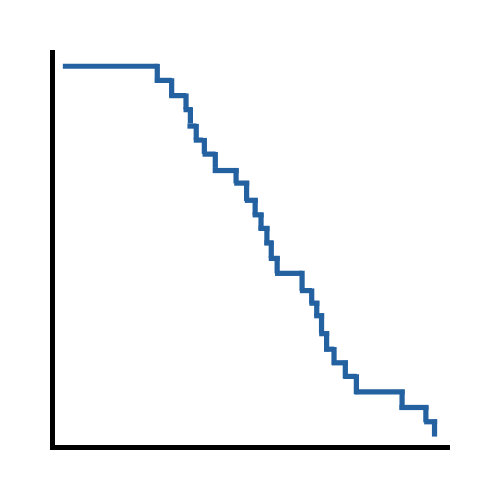online workshops
Introduction to Survival Analysis

You may find yourself with a research question where time is a dependent variable. Survival analysis (also called duration modelling in economics, reliability analysis in engineering, and event history analysis in sociology) is a whole set of statistical methods to turn to in order to answer these questions. learn more
the craft of statistical analysis free webinars
Introduction to Survival Analysis

Survival Analysis sounds like it should have a very narrow focus, but in fact, it’s an incredibly useful set of statistic tools that apply well in many fields. The defining feature of these models is that the dependent variable is the time until an event occurs. learn more
statistically speaking member trainings
An Introduction to Kaplan-Meier Curves

Survival data models provide interpretation of data representing the time until an event occurs. In many situations, the event is death, but it can also represent the time to other bad events such as cancer relapse or failure of a medical device. It can also be used to denote time to positive events such as pregnancy. learn more
Cox Regression

When you have data measuring the time to an event, you can examine the relationship between various predictor variables and the time to the event using a Cox proportional hazards model. We discuss what a hazard function is and describe the interpretations of increasing, decreasing, and constant hazard. learn more
Discrete Time Event History Analysis

What is the relationship between predictors and whether and when an event will occur? This is what event history (a.k.a., survival) analysis tests. There are many flavors of Event History Analysis, though, depending on how time is measured, whether events can repeat, etc. learn more
Types of Regression Models and When to Use Them

Linear, Logistic, Tobit, Cox, Poisson, Zero Inflated… The list of regression models goes on and on before you even get to things like ANCOVA or Linear Mixed Models. We explore types of regression models, how they differ, how they’re the same, and most importantly, when to use each one. learn more
articles at the analysis factor
What is Survival Analysis and When Can It Be Used?

There are two features of survival models. First is the process of measuring the time in a sample of people, animals, or machines until a specific event occurs. Second is the recognition that not everyone/everything in your sample will experience the event. learn more
How to Set up Censored Data for Event History Analysis

Censored data are inherent in any analysis, like Event History or Survival Analysis, in which the outcome measures the Time to Event (TTE). Censoring occurs when the event doesn’t occur for an observed individual during the time we observe them. learn more
Censoring in Time-to-Event Analysis

Time to event analyses are used often within medical, sales and epidemiological research. Some examples of time-to-event analysis are measuring the median time to death after being diagnosed with a heart condition, comparing male and female time to purchase after being given a coupon and estimating time to infection after exposure to a disease. learn more
Modeling Whether or When an Event Occurs: Event History Analysis

There are many types of outcome variables that don’t work in linear models, but look like they should. (I mean, specifically, OLS regression and ANOVA models). They include discrete counts; truncated or censored variables, where part of the distribution is cut off or measured only up to a certain point; and bounded variables, like proportions and percentages. learn more
What Is a Hazard Function in Survival Analysis?

One of the key concepts in Survival Analysis is the Hazard Function. But like a lot of concepts in Survival Analysis, the concept of “hazard” is similar, but not exactly the same as, its meaning in everyday English. Since it’s so important, though, let’s take a look. learn more
Six Types of Survival Analysis and Challenges in Learning Them

Survival analysis isn’t just a single model. It’s a whole set of tests, graphs, and models that are all used in slightly different data and study design situations. Choosing the most appropriate model can be challenging. I describe the most common types of tests and models in survival analysis, how they differ, and some challenges to learning them. learn more
The Proportional Hazard Assumption in Cox Regression

The Cox regression model has a fairly minimal set of assumptions, but how do you check those assumptions and what happens if those assumptions are not satisfied? learn more
Parametric or Semi-Parametric Models in Survival Analysis?

It was Casey Stengel who offered the sage advice, “If you come to a fork in the road, take it.” When you need to fit a regression model to survival data, you have to take a fork in the road. One road asks you to make a distributional assumption about your data and the other does not. learn more

